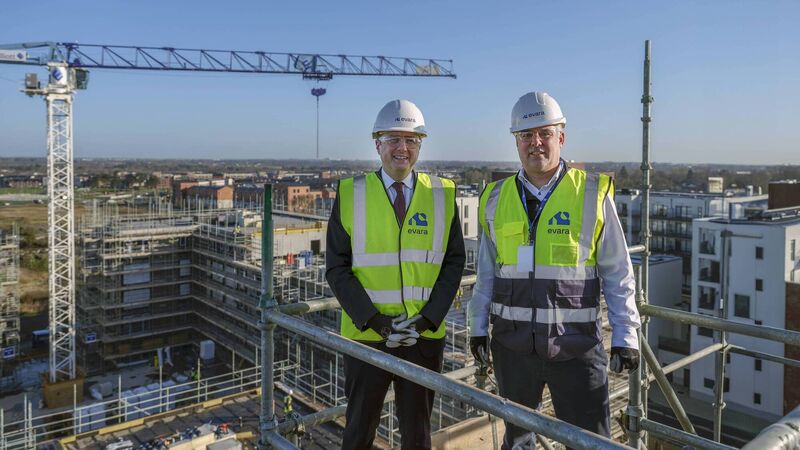Social housing target increased to 12,000 units per year as part of new plan

Housing minister James Browne and Evara CEO Michael Hynes at The Irons in Adamstown, Co Dublin earlier this year. The Government's new plan is expected to include a recommendation to accelerate the construction of new urban towns such as Adamstown. File picture: Colm Kerr
The Government is targeting the delivery of 12,000 new social homes each year as part of its revised housing plan.
Ministers are expected to sign off on the plan today, Monday, at a meeting of the Cabinet committee on housing, before it is formally adopted by Cabinet on Wednesday.
Sources confirmed the revised plan would be split into two sections, the first of which deals with activating land for housing, and the second focuses on supports for people — including those in homelessness and the elderly.
Under the previous Housing for All plan, the Government had targeted the delivery of 10,200 social homes per year from 2026 onwards.
This will now increase to 12,000 under the new plan.
One senior government minister said a more significant element of the policies will be formed by the report from the accelerating infrastructure taskforce early in December. The source said:
The source added that it will include recommendations to provide for emergency legislation to deliver key infrastructure projects.
It is understood that proposals within the new plan include a national audit of zoned, serviced, and unzoned land to be carried out regularly.
This, sources said, will help plan towards the delivery of 300,000 homes by the end of 2030.
The plan also calls for a scale to be introduced for environmental legal costs and a recommendation for a review of development contributions.
These contributions are paid by developers to local authorities, with rates varying across the country. The funds raised are typically used to fund public infrastructure such as footpaths.
The plan also includes a recommendation to accelerate the construction of new urban towns, citing the impact of areas such as Adamstown.
There has been some effort to play down the scope of the plan in recent days, with senior sources indicating significant portions have already been unveiled.
This includes reforms made to rent pressure zones, changes to apartment size guidelines, as well as changes to the Vat rate on apartments provided for in Budget 2026.
It comes as a deal between the Government and Ireland’s major banks to provide funding for small builders is said to be close.
The deal itself would see Ireland’s sovereign wealth fund, the Ireland Strategic Investment Fund, match funding provided to small and medium developers by the banks.
Funding would also be provided at a reduced interest rate.
Taoiseach Micheál Martin first signalled a deal was on the table, in late October with negotiations still underway with the pillar banks of AIB, Bank of Ireland, and PTSB.
One government source said they are hopeful agreement will be reached “very soon”.
“At the moment, a few large developers are building most of the housing, with SMEs finding it difficult due to constraints in accessing finance,” the source said.
“This funding increase will be particularly helpful in getting more housing developments built in rural towns and villages.”
The Taoiseach also met with the chief executives of a number of local councils last week — including Dublin City, Fingal, Kildare, and Wicklow — to press for more zoned lands.













